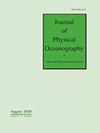南海具有透镜状低位涡度的变质层内涡及二重强迫机制
IF 2.8
2区 地球科学
Q1 OCEANOGRAPHY
引用次数: 0
摘要
海洋中普遍存在以表层下透镜状低位涡度(PV)为特征的层内涡度(ITEs)。然而,由于这些低位涡透镜体的表面信号微弱,且体积庞大,给观测带来了障碍,因此人们对它们的丰度和生成机制知之甚少。利用南海北部(NSCS)的原位观测,于 2021 年 5 月捕获了一个典型的 ITE,其透镜状低 PV 核心深度为 30-150 米,水平尺寸约为 150 千米。结合PV预算分析,我们利用高分辨率再分析产品研究了这些ITE内低PV的基本生成机制。结果表明,冬季由大气绝热强迫而非摩擦强迫驱动的表面浮力损失是 ITE 形成的关键有利条件。这些增强的地表浮力损失会产生向上的净PV通量,并降低弱层状和深层冬季混合层中的PV,而这些混合层是由反气旋涡旋(AEs)预设的。第二年春季的地表加热往往会减弱地表浮力损失,并逐渐导致 PV 通量下降,而地表注入的高 PV 随后会封住地表强化 AE 内的低 PV 水,并将其转化为 ITE。在 NSCS 卫星测高仪探测到的 58 个 AE 中,约有 22% 是 ITE。更重要的是,其中的透镜状低PV主要是由冬季增强的表面浮力损失产生的。这些发现为 ITE 中低 PV 的产生提供了新的动态解释,突出了大气绝热强迫的关键作用。本文章由计算机程序翻译,如有差异,请以英文原文为准。
Intrathermocline eddy with lens-shaped low potential vorticity and diabatic forcing mechanism in the South China Sea
Intrathermocline eddies (ITEs), characterized by subsurface lens-shaped low potential vorticity (PV), are pervasive in the ocean. However, the abundance and generation mechanisms of these low-PV lenses are poorly understood owing to their weak surface signals and awkward sizes, which present an observational barrier. Using in-situ observations of the northern South China Sea (NSCS), a typical ITE with a lens-shaped low PV at a core depth of 30-150 m and a horizontal size of ~150 km was captured in May 2021. Combined with PV budget analysis, we investigate the underlying generation mechanism of low PVs within these ITEs using high-resolution reanalysis products. The results suggest that wintertime surface buoyancy loss driven by atmospheric diabatic forcing rather than frictional forcing is a crucial favorable condition for the ITE formation. These enhanced surface buoyancy losses produce a net upward PV flux and decrease PV in the weakly-stratified and deep winter mixed layer, which are preconditioned by anticyclonic eddies (AEs). While surface heating in the following spring tends to weaken the surface buoyancy loss and gradually causes a downward PV flux, the surface-injected high PV subsequently caps the low-PV water within the surface-intensified AEs and transforms them into ITEs. Approximately 22% of the 58 AEs detected by satellite altimetry in the NSCS are ITEs. More importantly, the lens-shaped low PVs within them are produced primarily by the enhanced surface buoyancy loss during wintertime. These findings provide a new dynamic explanation for the low-PV generation in ITEs, highlighting the crucial role of atmospheric diabatic forcing.
求助全文
通过发布文献求助,成功后即可免费获取论文全文。
去求助
来源期刊
CiteScore
2.40
自引率
20.00%
发文量
200
审稿时长
4.5 months
期刊介绍:
The Journal of Physical Oceanography (JPO) (ISSN: 0022-3670; eISSN: 1520-0485) publishes research related to the physics of the ocean and to processes operating at its boundaries. Observational, theoretical, and modeling studies are all welcome, especially those that focus on elucidating specific physical processes. Papers that investigate interactions with other components of the Earth system (e.g., ocean–atmosphere, physical–biological, and physical–chemical interactions) as well as studies of other fluid systems (e.g., lakes and laboratory tanks) are also invited, as long as their focus is on understanding the ocean or its role in the Earth system.

 求助内容:
求助内容: 应助结果提醒方式:
应助结果提醒方式:


